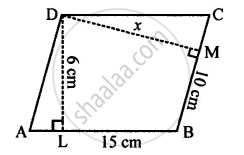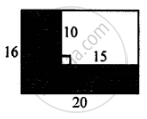Advertisements
Advertisements
प्रश्न
The adjacent sides of a parallelogram are 15 cm and 10 cm. If the distance between the longer sides is 6 cm, find the distance between the shorter sides.
उत्तर
In parallelogram ABCD
AB = DC = 15 cm
BC = AD = 10 cm

Distance between longer sides AB and DC is 6 cm
i.e., perpendicular DL = 6 cm
DM ⊥ BC
Area of parallelogram = Base × Altitude
= AB × DL = 15 × 6 = 90 cm2
Again let DM = x cm
∴ Area of parallelogram ABCD = BC × DM
= 10 × x = 10x cm2
∴ 10x cm2 = 90 cm2
⇒ x = `90/10` = 9 cm
APPEARS IN
संबंधित प्रश्न
Find the area of the square whose perimeter is 56 cm.
In the figure given below, find the area of shaded region: (All measurements are in cm)

In the figure given below, find the area of shaded region: (All measurements are in cm)

The base of a parallelogram is thrice it height. If its area is 768 cm2, find the base and the height of the parallelogram.
The area of a rhombus is 84 cm2 and its perimeter is 56 cm. Find its height.
The sides of a triangle are in the ratio 15 : 13 : 14 and its perimeter is 168 cm. Find the area of the triangle.
The diameter of a circle is 20 cm. Taking π = 3.14, find the circumference and its area.
The ratio between the radius of two circles is 5 : 7. Find the ratio between their:
(i) circumference
(ii) areas
The length and breadth of a rectangular paper are 35 cm and 22 cm. Find the area of the largest circle which can be cut out of this paper.
From each corner of a rectangular paper (30 cm x 20 cm) a quadrant of a circle of radius 7 cm is cut. Find the area of the remaining paper i.e., shaded portion.

